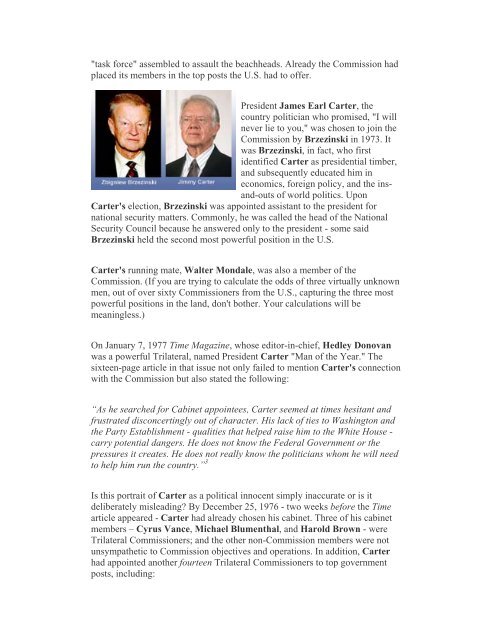70-years-chart-illustrates-the-dominance-by-the-cfr-trilaterals-bilderbergers
70-years-chart-illustrates-the-dominance-by-the-cfr-trilaterals-bilderbergers
70-years-chart-illustrates-the-dominance-by-the-cfr-trilaterals-bilderbergers
Create successful ePaper yourself
Turn your PDF publications into a flip-book with our unique Google optimized e-Paper software.
"task force" assembled to assault <strong>the</strong> beachheads. Already <strong>the</strong> Commission had<br />
placed its members in <strong>the</strong> top posts <strong>the</strong> U.S. had to offer.<br />
President James Earl Carter, <strong>the</strong><br />
country politician who promised, "I will<br />
never lie to you," was chosen to join <strong>the</strong><br />
Commission <strong>by</strong> Brzezinski in 1973. It<br />
was Brzezinski, in fact, who first<br />
identified Carter as presidential timber,<br />
and subsequently educated him in<br />
economics, foreign policy, and <strong>the</strong> insand-outs<br />
of world politics. Upon<br />
Carter's election, Brzezinski was appointed assistant to <strong>the</strong> president for<br />
national security matters. Commonly, he was called <strong>the</strong> head of <strong>the</strong> National<br />
Security Council because he answered only to <strong>the</strong> president - some said<br />
Brzezinski held <strong>the</strong> second most powerful position in <strong>the</strong> U.S.<br />
Carter's running mate, Walter Mondale, was also a member of <strong>the</strong><br />
Commission. (If you are trying to calculate <strong>the</strong> odds of three virtually unknown<br />
men, out of over sixty Commissioners from <strong>the</strong> U.S., capturing <strong>the</strong> three most<br />
powerful positions in <strong>the</strong> land, don't bo<strong>the</strong>r. Your calculations will be<br />
meaningless.)<br />
On January 7, 1977 Time Magazine, whose editor-in-chief, Hedley Donovan<br />
was a powerful Trilateral, named President Carter "Man of <strong>the</strong> Year." The<br />
sixteen-page article in that issue not only failed to mention Carter's connection<br />
with <strong>the</strong> Commission but also stated <strong>the</strong> following:<br />
“As he searched for Cabinet appointees, Carter seemed at times hesitant and<br />
frustrated disconcertingly out of character. His lack of ties to Washington and<br />
<strong>the</strong> Party Establishment - qualities that helped raise him to <strong>the</strong> White House -<br />
carry potential dangers. He does not know <strong>the</strong> Federal Government or <strong>the</strong><br />
pressures it creates. He does not really know <strong>the</strong> politicians whom he will need<br />
to help him run <strong>the</strong> country.” 3<br />
Is this portrait of Carter as a political innocent simply inaccurate or is it<br />
deliberately misleading By December 25, 1976 - two weeks before <strong>the</strong> Time<br />
article appeared - Carter had already chosen his cabinet. Three of his cabinet<br />
members – Cyrus Vance, Michael Blumenthal, and Harold Brown - were<br />
Trilateral Commissioners; and <strong>the</strong> o<strong>the</strong>r non-Commission members were not<br />
unsympa<strong>the</strong>tic to Commission objectives and operations. In addition, Carter<br />
had appointed ano<strong>the</strong>r fourteen Trilateral Commissioners to top government<br />
posts, including:


